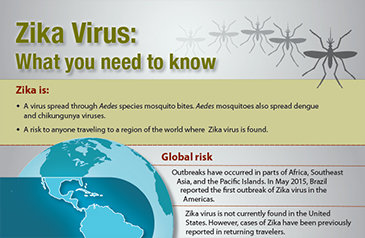Fighting climate change is critical to controlling the spread of the Zika virus

By Dr Anthony Horton
News of the Zika virus outbreak in Brazil has prompted me to consider two environmental aspects affecting the control of infectious disease. Firstly, how changes in climate are influencing the abundance and seasonality of disease vectors which place humans at greater risk of infection. Vectors are animals such as mosquitoes that transmit viruses to humans or other animals they come into contact with. Secondly, how much we have learnt from recent history given that the link between vector-borne infection and climatic conditions has been studied for at least the last two decades (based on my review of the available scientific findings). My findings emphasise the importance of combating global climate change as a crucial factor in controlling the spread of the Zika virus and other vector-borne diseases in the future.
In 2000 the World Health Organisation (WHO) Bulletin published an article entitled ‘Climate change and vector-borne diseases: a regional analysis’ discussing the latest research at the time, looking at the role that rising temperatures play in increasing the transmission of vector-borne disease. This analysis focused on a number of regions around the world including Africa, South and North America, Asia, Australia and New Zealand.
Mosquito species are responsible for transmitting most vector-borne diseases
The WHO Bulletin noted that mosquito species are responsible for transmitting most vector-borne diseases reported to medical authorities – including the Zika virus, which is related to dengue fever, yellow fever and the West Nile virus. These species are very sensitive to temperature changes, both as larvae in aquatic environments and as adults. Higher water temperatures mean these larvae will mature quicker and produce more offspring. In warmer climates, female adult mosquitoes digest blood faster and feed more frequently, which means increased breeding rates and therefore higher mosquito populations. Higher breeding rates and larvae maturing faster means that there are more disease-carrying mosquitoes transmitting disease to both humans and animals that come into contact with humans.
Changing rainfall patterns have short and long-term effects on vector disease carrier’s habitats. Higher rainfall can increase the number and quality of breeding sites for mosquitoes, ticks and snails – all of which can transmit viruses to humans and other animals they come into contact with. Patterns of human settlement can also influence trends in disease transmission
Looking at this research, I was particularly interested in the WHO’s analysis of the influence of temperature ranges on growth and development stages of mosquitoes that transmit diseases such as the Zika virus. They noted that for many diseases, incubation in vectors is interrupted at 14-18°C as this temperature is too low to drive the required biological processes. As temperatures rise, malaria parasites and viruses complete their incubation period in female mosquitoes faster. At 35-40°C, disease transmission may decline due to higher vector death rates which reduce the number of breeding age mosquitoes.
The WHO report also pointed out that tropical temperate climates in Asia provide ideal climatic conditions for the spread of a number of diseases. These include malaria, dengue fever, dengue haemorrhagic fever and schistosomiasis. Research has shown that El Niño and other weather events may also play a significant part in making conditions more favourable to the establishment and maintenance of mosquito populations.
In additional research, September 2013 saw a team from the University of Arizona (UofA) School of Geography and Development investigate the abundance and seasonality of West Nile virus vectors in their article entitled ‘Regional and seasonal response of a West Nile virus vector to climate change’. Their article was published in the Proceedings of the National Academy of Sciences.
The UofA research team focused on the investigation of the vector Culex quinquefasciatus because it feeds on bird and human hosts, is found in urban environments, and is suspected to be the primary vector of the West Nile Virus in many southern US states. As changes in climate can differ between locations and over time, mosquito sensitivity to these changes is dependent on the seasonal timing and intensity of rainfall. Warmer temperatures can extend the period of time that mosquito populations are active. Therefore as virus incubation periods decrease, they can spread within the mosquito population faster, meaning that viruses can ultimately be transmitted faster.
Climate change will modify seasonal mosquito population levels
These researchers concluded that climate change will modify seasonal mosquito population levels across the US, and thus public health interventions must be robust enough to account for site-specific climate changes in order to implement the most effective strategies to control the transmission of the West Nile virus to humans. Further research is needed to better understand the response of birds carrying the West Nile virus to climate change. The implications of changes in land cover and land use also need to be investigated as these changes can influence how resistant the land is to drying – because if land is more resistant to drying, more water can collect, which can in turn facilitate the establishment of mosquito populations.
The Zika virus is clearly one that we need to pay close attention to from both human health and environmental perspectives
Based on what has been reported in the media to date, the Zika virus is clearly one that we need to pay close attention to from both human health and environmental perspectives. The health consequences are clearly horrendous and can’t be ignored. Based on the scientific literature, I would suggest that the evidence of a link between changes in climate and the spread of vector-borne diseases is also one that can’t be ignored.
As a scientist I would like to believe that the Zika virus outbreak could finally be the incident that awakens the world from inaction on climate change as we realise that it’s a vital component to the control of infectious disease. As a realist though, I fear that the next time a vector-borne disease outbreak occurs, we will give due attention to the symptoms but may not pay equal attention to fighting climate change which is critical to controlling the spread of the Zika virus and other similar infectious diseases.
 About the author: Anthony Horton holds a PhD in Environmental Science, a Bachelor of Environmental Science with Honours and a Diploma of Carbon Management. He has a track record of delivering customised solutions in Academia, Government, the Mining Industry and Consulting based on the latest wisdom and his scientific background and experience in Climate/Atmospheric Science and Air Quality. Anthony’s work has been published in internationally recognised scientific journals and presented at international and national conferences, and he is currently on the Editorial Board of the Journal Nature Environment and Pollution Technology. Anthony also blogs on his own site, The Climate Change Guy.
About the author: Anthony Horton holds a PhD in Environmental Science, a Bachelor of Environmental Science with Honours and a Diploma of Carbon Management. He has a track record of delivering customised solutions in Academia, Government, the Mining Industry and Consulting based on the latest wisdom and his scientific background and experience in Climate/Atmospheric Science and Air Quality. Anthony’s work has been published in internationally recognised scientific journals and presented at international and national conferences, and he is currently on the Editorial Board of the Journal Nature Environment and Pollution Technology. Anthony also blogs on his own site, The Climate Change Guy.
Like what we do at The AIMN?
You’ll like it even more knowing that your donation will help us to keep up the good fight.
Chuck in a few bucks and see just how far it goes!
Your contribution to help with the running costs of this site will be gratefully accepted.
You can donate through PayPal or credit card via the button below, or donate via bank transfer: BSB: 062500; A/c no: 10495969









